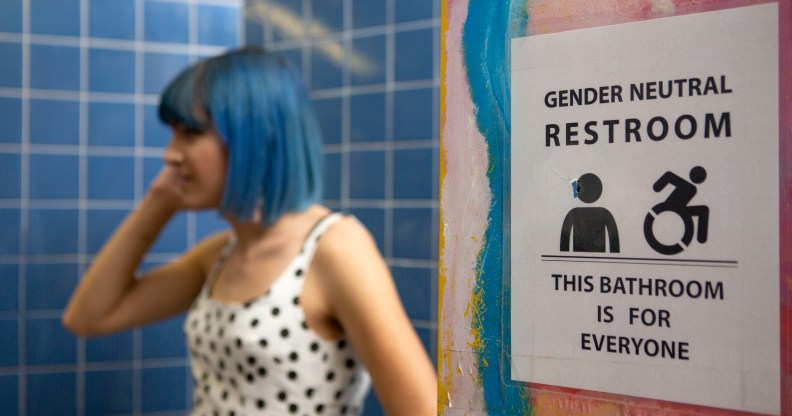Pubs and clubs urged to let trans people ‘pee in peace’ in major new bathroom campaign

Stock photo of a transgender person in an all-gender bathroom. (Creative Commons/Zackary Drucker/Broadly Gender Spectrum Collection)
Pubs, clubs and bars are being urged to make their toilets safer for trans people and more accessible to people of all genders by a feminist group that works to prevent sexual violence.
The call to provide gender-inclusive toilets comes after the government began a review of toilet provision, a move that was widely criticised by LGBT+ groups for being hostile to trans and non-binary people.
The Good Night Out Campaign, which works with venues to create safer nightlife, partnered with LGBT+ anti-violence charity Galop on the toolkit to promote gender-inclusive toilets. The guidance aims to combat misinformation – like the transphobic myth that gender-neutral toilets are dangerous – and support better access to safe loos for everyone.
Trans people have always used the toilet that fits their gender, and this was enshrined as a right under the 2010 Equality Act. But increasingly hostile transphobia in the UK means that many venues that have introduced all-gender bathrooms have been met with backlash, often spearheaded by anti-trans campaigners who promote misinformation about safety and queues.
A report from Galop in 2020 found that as a result, half of trans people in the UK are too afraid to use public toilets.
Bryony Beynon, director of the Good Night Out Campaign, said: “We know sexual harassment and assault are deeply gendered, impacting women and LGTBQ+ people disproportionately. However, enforcing gender norms by policing bathrooms through compulsory segregation or assuming where someone ‘should’ be does not prevent violence and can actually help create a conducive context for it.
“Given the atmosphere of fear and disinformation, we wanted to cut through the noise and provide some caring, common sense guidance on this issue. What’s more, when bathroom options that work for everyone help trans, non-binary and gender non-conforming visitors to feel safer and more welcome, that makes business sense, too!”
The toolkit provides suggestions on signage, refitting and redesignating, evidence from academic studies and research that debunk common myths, as well as testimony from trans and non-binary people who face stress, harassment and even violence simply when trying to use the loo.
There is a misconception that gender-inclusive toilets increase queues for the loos, which disproportionately impacts women. However, a 2017 study suggested that when planned correctly, all-gender bathrooms result in the lowest combined wait time overall.
And it’s not only trans people who would benefit from more inclusive toilet provision – butch lesbians report being harassed in women’s bathrooms as anti-trans hostility increases.
A 30-year-old cis woman, Rachel, who identifies as butch, told the Good Night Out Campaign that using public toilets as a masculine-presenting women is “an everyday struggle”.
“This has been made worse since the pandemic with facemasks,” Rachel said. “I don’t want to make anyone feel uncomfortable, but I also don’t want to somehow prove my gender to strangers.”
She continued: “In spaces where I expect the crowd will be less understanding, I avoid women’s toilets and opt for the wheelchair accessible one (though that is not ideal). In venues with mixed toilets or signs, I just don’t have to worry about any of that. I can actually just pee in peace.”

